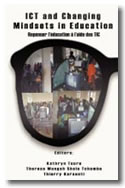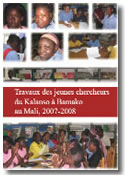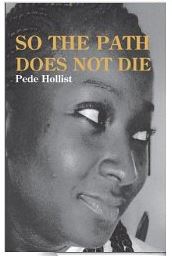Novel by Sierra Leonean wins 2013 literary award May 3, 2014
Pede Hollist’s So the Path Does Not Die, published by Langaa in 2012, was named 2013 Book of the Year for Creative Writing by the African Literature Association (ALA) at its annual meeting in April 2014 in Johannesburg, South Africa.This award is for an outstanding book of African literature, whether novel, nonfiction prose, play, or poetry collection, published in the preceding calendar year by an African writer. Part of the award citation reads as follows: “A novel written in the form of a memoir, it tells the story of coming into age, or gaining a consciousness amongst the ruins, human and physical, of a country… One gets an idea of schooling, of friendships, of humor in relationships, and of challenges facing the protagonists… The narrative tension is kept alive by a manner of writing that is quite settled. There is a clear mastery of the art of the sentence…”
Read more about the novel and find how to order it as a paperback or as an e-book: www.langaa-rpcig.net/So-the-Path-Does-Not-Die.html




So the Path does not Die
by Pede Hollist
Langaa Publishing, http://www.langaa-rpcig.net, 282 pages, $22.46 on Amazon.com, $7.99 for Kindle edition, £17.95 on Amazon.uk, see African Books Collective at http://www.africanbookscollective.com/books/so-the-path-does-not-die for ebook at £6.99
Dislocation of her family after her father’s courageous refusal of excision for his daughter, following the death of an elder child as a result of the practice, leads to a lifetime of exclusion and trials for Finaba Marah. Despite the fears of her Sierra Leonean community, she never loses her attachment to “the Path” of respect and love for her family, concern for others, and a clear perception of justice. After achieving apparent success in the USA, she feels impelled to return to her country after it has been ravaged by civil war, to search for her eldest surviving relative and care for children suffering from the effects of conflict.
As for most young people, her ideal is to find herself in a place where people think as she does and do not consider her in some way “foreign”. But this dream is shattered at the very moment when she is about to undergo female genital cutting (FGC) and initiation in a forest village ceremony to bind her to her community’s traditional path that is unquestioningly followed by her grandmother, Baramuso, more fearfully by her mother who lost her first daughter, but rejected angrily by her father, Amadu, who rebels against tradition and snatches Fina from the initiation hut in the forest, breaking the taboo against any approach by men. Reaction is so ferocious, especially among older women, that the family is forced into exile.
First comes the flight to Freetown without hope of return to the village, and thus into urban poverty and dependency on rich relatives. When her father dies, she is sent to live with these relatives and is able to do well at school, but is unhappy and narrowly misses sexual abuse. From there she goes to college but feels rejected because of her ethnicity and drops out, works for a few years with a young American missionary who exploits Fina’s attractions for the local plutocracy. From there she moves to her American dream but lives the dilemmas facing the African diaspora, finally meeting the successful Caribbean doctor who undoubtedly loves her and wants to marry her. An epic wedding scene (this would make a good film) places Africans and Caribbeans in hilarious conflict, but convinces Fina that she needs to return to Sierra Leone “where she belongs”. There, shortly after the end of the Civil War, she discovers the fate of former child soldiers, and finally lays to rest her other dream, of finding her grandmother who died in the hostilities. She is last seen courted by both her would-be Trinidadian husband and a rich Sierra Leonean merchant who adores her, while she assumes responsibility for herself and many others: the damaged children she cares for, her daughter, an adopted child and a surrogate grandmother, uncertain if her future lies in Africa or in the US.
Fina does not spend much time lamenting her fate, and this is a fast-moving novel, revealing how racial and cultural differences affect young women on two continents. Nevertheless, there is no doubt that the root of her family’s problems lie in ancestral feelings about the significance of FGC as a test for the path that should not be allowed to die and that the village feels her family has violated. However, it is optimistic because early family affection and solidarity is shown to produce the results that society aims for, without the aggression and trauma tradition recommended for young girls. Fina is conscious of the need to preserve what is good in both traditional and modern society, and she names her daughter after the sister she lost in her village, feeling responsibility for giving her child an American education, and to follow other ways of keeping the path alive. She remembers the elderly sage in her grandmother’s favorite folk story who said: “To be at home means knowing one’s self and sharing that self with others.”
The book has a strong sense of story, a believable central character and representatives of a variety of points of view. It is highly recommended first because it gives a voice to societies that are reluctant to give up the FGC tradition, and to young women who are lonely and vulnerable in urban society. Then it is an eye-opener for those who attempt to understand rather than condemn outright the impact of the FGC tradition on West African lives, and for the light it sheds on inter-community life in urban Africa (Sierra Leone turns out to be another country living with the strain and danger of inter-ethnic hostility), between African Americans and the African diaspora, and between West Africans and the Caribbean population in the US. This is a lot to pack into one book, and Hollist’s triumph is to propel the reader through so many interesting social themes.
Violet Diallo
Bamako, August 2012 – resurrected April 2014